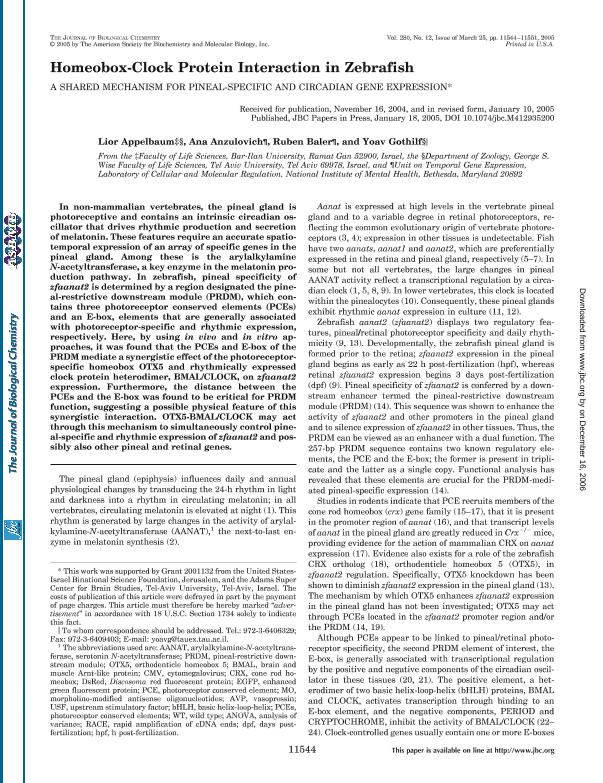Mostrar el registro sencillo del ítem
dc.contributor.author
Appelbaum, Lior
dc.contributor.author
Anzulovich Miranda, Ana Cecilia

dc.contributor.author
Baler, Ruben
dc.contributor.author
Gothilf, Yoav
dc.date.available
2022-06-03T15:40:51Z
dc.date.issued
2005-03
dc.identifier.citation
Appelbaum, Lior; Anzulovich Miranda, Ana Cecilia; Baler, Ruben; Gothilf, Yoav; Homeobox-Clock protein interaction in zebrafish: a shared mechanism for pineal-specific and circadian gene expression; American Society for Biochemistry and Molecular Biology; Journal of Biological Chemistry; 280; 12; 3-2005; 11544-11551
dc.identifier.issn
0021-9258
dc.identifier.uri
http://hdl.handle.net/11336/158902
dc.description.abstract
In non-mammalian vertebrates, the pineal gland is photoreceptive and contains an intrinsic circadian oscillator that drives rhythmic production and secretion of melatonin. These features require an accurate spatiotemporal expression of an array of specific genes in the pineal gland. Among these is the arylalkylamine N-acetyltransferase, a key enzyme in the melatonin production pathway. In zebrafish, pineal specificity of zfaanat2 is determined by a region designated the pineal-restrictive downstream module (PRDM), which contains three photoreceptor conserved elements (PCEs) and an E-box, elements that are generally associated with photoreceptor-specific and rhythmic expression, respectively. Here, by using in vivo and in vitro approaches, it was found that the PCEs and E-box of the PRDM mediate a synergistic effect of the photoreceptor-specific homeobox OTX5 and rhythmically expressed clock protein heterodimer, BMAL/CLOCK, on zfaanat2 expression. Furthermore, the distance between the PCEs and the E-box was found to be critical for PRDM function, suggesting a possible physical feature of this synergistic interaction. OTX5-BMAL/CLOCK may act through this mechanism to simultaneously control pineal-specific and rhythmic expression of zfaanat2 and possibly also other pineal and retinal genes.
dc.format
application/pdf
dc.language.iso
eng
dc.publisher
American Society for Biochemistry and Molecular Biology

dc.rights
info:eu-repo/semantics/openAccess
dc.rights.uri
https://creativecommons.org/licenses/by/2.5/ar/
dc.subject
NON-MAMMALIAN VERRTEBRATE
dc.subject
PINEAL GLAND
dc.subject
A-NAT
dc.subject
CIRCADIAN RHYTHM
dc.subject.classification
Biología Celular, Microbiología

dc.subject.classification
Ciencias Biológicas

dc.subject.classification
CIENCIAS NATURALES Y EXACTAS

dc.title
Homeobox-Clock protein interaction in zebrafish: a shared mechanism for pineal-specific and circadian gene expression
dc.type
info:eu-repo/semantics/article
dc.type
info:ar-repo/semantics/artículo
dc.type
info:eu-repo/semantics/publishedVersion
dc.date.updated
2022-05-20T15:08:24Z
dc.journal.volume
280
dc.journal.number
12
dc.journal.pagination
11544-11551
dc.journal.pais
Estados Unidos

dc.journal.ciudad
Maryland
dc.description.fil
Fil: Appelbaum, Lior. Bar-Ilan University. Faculty of Life Sciences; Israel. Universitat Tel Aviv; Israel
dc.description.fil
Fil: Anzulovich Miranda, Ana Cecilia. Consejo Nacional de Investigaciones Científicas y Técnicas. Centro Científico Tecnológico Conicet - San Luis. Instituto Multidisciplinario de Investigaciones Biológicas de San Luis. Universidad Nacional de San Luis. Facultad de Ciencias Físico Matemáticas y Naturales. Instituto Multidisciplinario de Investigaciones Biológicas de San Luis; Argentina. National Institutes of Health; Estados Unidos
dc.description.fil
Fil: Baler, Ruben. National Institutes of Health; Estados Unidos
dc.description.fil
Fil: Gothilf, Yoav. Universitat Tel Aviv; Israel
dc.journal.title
Journal of Biological Chemistry

dc.relation.alternativeid
info:eu-repo/semantics/altIdentifier/url/https://www.jbc.org/article/S0021-9258(20)80859-X/fulltext
dc.relation.alternativeid
info:eu-repo/semantics/altIdentifier/doi/https://doi.org/10.1074/jbc.M412935200
Archivos asociados
